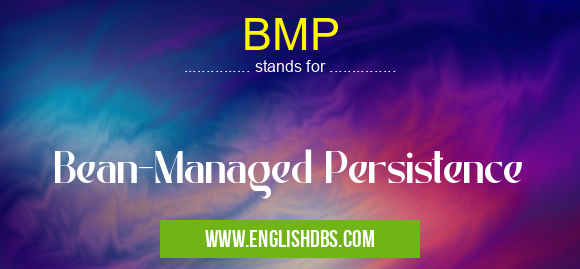What does BMP mean in NETWORKING
Bean-Managed Persistence (BMP) is a Java Enterprise Edition (EE) technology that enables developers to interact directly with the underlying database, using low-level APIs. This stands in contrast to Container Managed Persistence (CMP), where developers interact with the database through higher-level abstraction layers such as Entity Beans. BMP is useful for scenarios where CMP cannot handle more complex transactional requirements or when manual data manipulation and control are desired. It can also offer superior performance in certain cases.

BMP meaning in Networking in Computing
BMP mostly used in an acronym Networking in Category Computing that means Bean-Managed Persistence
Shorthand: BMP,
Full Form: Bean-Managed Persistence
For more information of "Bean-Managed Persistence", see the section below.
» Computing » Networking
What is BMP?
Bean-Managed Persistence enables developers to write and deploy code that performs direct data manipulation on an underlying database or resource manager, such as an RDBMS or Oracle Database. These operations can be used to create, read, update and delete records inside the database, as well as perform transactions across multiple databases or other resources involving inserts/updates/deletes within a single transaction boundary. Since BMP allows direct access to the underlying data store, it provides greater flexibility than CMP over how the data is manipulated.
Advantages of BMP
The main advantage of Bean-Managed Persistence is direct access to the data store which makes it possible for developers to take advantage of certain features that may not be available in CMP implementations such as triggers within databases or usage of stored procedures for advanced functionality. It can also provide better performance due to less code between the application layer and the data store level, allowing more efficient access and manipulation of records compared to CMP based approaches which may involve additional "round trips" between these two layers for each operation requested by an application user or process. Finally, because beans are tied directly into the underlying database using SQL calls they can easily integrate with existing systems without having to write additional wrappers around them like some other technologies might require.
Essential Questions and Answers on Bean-Managed Persistence in "COMPUTING»NETWORKING"
What is Bean-Managed Persistence (BMP)?
Bean-Managed Persistence (BMP) is a type of persistence management used in Java Enterprise Edition (JEE). It is a programming model that enables the developer to manage the persistence logic using application server APIs and resource managers, such as databases. BMP can be used to reduce complexity of message-driven bean implementation, while providing an easy way to access data stored in databases.
What are the advantages of using BMP?
There are several advantages of using BMP. Firstly, it provides developers with full control over their database access code, allowing them to customize or optimize complex SQL queries. Additionally, BMP increases performance by avoiding unnecessary data transfer between application components and helps in reducing redundancy caused by dynamically generated SQL statements. Lastly, it ensures better maintainability since all the database operations are handled in one place.
How can I implement BMP?
Implementing BMP requires some knowledge of JDBC and interacting with Entity Beans. To start you will need to use an Entity Bean class and create an entity bean instance for each row in your database table. These entities will contain methods needed for retrieval and manipulation of the underlying data structure as well as getter/setter methods for accessing properties across the entity instances. Finally you will need to write code that accesses the Entity Bean’s getter/setter methods and interacts with your database tables via JDBC API calls such as sqlQuery() or executeUpdate().
What are the disadvantages of using BMP?
The main disadvantage of using BMP is that it adds more coding overhead when compared to Container Managed Persistence (CMP). As everything must be coded manually, there is potential for difficult debugging with larger projects due to configuration issues or incorrect code usage. Additionally if any changes are required within a codebase written using BPM it may become difficult to locate specific sections which makes maintenance more challenging than CPM solutions.
Do I have any alternatives for using BPM?
Yes, you do have alternative solutions available for using instead of Bean Managed Persistence (BPM). Container Managed Persistence (CPM) has been developed as a response to address many issues developers faced when dealing with large applications requiring database communication which eliminates most coding requirements found in Bean-Managed Persistence solutions. Additionally frameworks such as Hibernate offer great flexibility and scalability when dealing with large databases.
Is there support available when writing my own queries?
Yes, there is support available when writing custom queries on top of existing Entity Beans implementation with JEE applications supporting Bean-Managed Persistence (BPM). As Oracle supplies many tutorials containing examples on how you would go about implementing this type of solution you may find assistance from its documentation libraries helpful if any issues arise during development process.
Are there security concerns related to implementing custom queries?
Security concerns should always be taken into account when working with customer queries but fortunately this isn’t too big issue if you take proper steps towards proper authentication and authorization before each query execution process begins. This includes verifying user roles associated with requested operation before any action takes place on remote resources.
Final Words:
Bean-Managed Persistence offers many advantages over other technologies for accessing relational databases in Java EE applications. Its ability to make direct calls into the underlying database provides greater flexibility while still providing a secure interface for interacting with third party systems and components. Additionally it often yields better performance than its alternatives due to reduced overhead from abstraction layers present in other approaches like Container Managed Persistence (CMP). The key takeaway here is that depending on your particular use case there may be times when BMP is preferable over CMP despite its added complexity; so it’s something every developer should be aware of and consider when crafting their applications.
BMP also stands for: |
|
| All stands for BMP |
